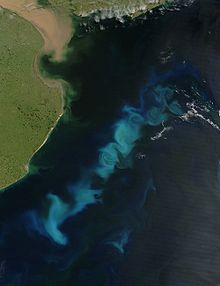Three weeks ago, on April 20, the offshore oil rig Deepwater Horizon exploded and sunk in the gulf of Mexico. This event marked the start of a massive and ongoing oil spill. Since then, many attempts have been made to stem the flow, but with little
success. An estimated 5,000 barrels of oil continues to spill into the gulf every single day.
(images have suffered from blog auto-format. Please click for full view - it's worth it.)

Seawater covered with thick black oil splashes up in brown-stained whitecaps off the side of the supply vessel Joe Griffin at the site of the Deepwater Horizon oil spill containment efforts in the Gulf of Mexico off the coast of Louisiana Sunday, May 9, 2010. (AP Photo/Gerald Herbert)

Oil burns during a controlled fire May 6, 2010 in the Gulf of Mexico. The U.S. Coast Guard is overseeing oil burns after the sinking, and subsequent massive oil leak, from the sinking of the Deepwater Horizon oil platform off the coast of Louisiana. (Justin E. Stumberg/U.S. Navy via Getty Images)

A pod of Bottlenose dolphins swim under the oily water Chandeleur Sound, Louisiana, Thursday, May 6, 2010 in the Gulf of Mexico. (AP Photo/Alex Brandon)

A man holds a plastic bag with seawater and oil from the Gulf of Mexico oil spill south of Freemason Island, Louisiana May 7, 2010. (REUTERS/Carlos Barria)

Mississippi River water (left) meets sea water and an oil slick that has passed inside of the protective barrier formed by the Chandeleur Islands, off the coast of Louisiana, on May 7, 2010. (MARK RALSTON/AFP/Getty Images)

Heather Neville of Tristate Bird Rescue and Research rinses off an oiled brown pelican which was captured on a barrier island off the fragile Louisiana coast on Tuesday, May 4, 2010 at a triage center in Fort Jackson, Louisiana. (MIRA OBERMAN/AFP/Getty Images)

An oil soaked bird struggles against the oil slicked side of the HOS Iron Horse supply vessel at the site of the Deepwater Horizon oil spill in the Gulf of Mexico off the coast of Louisiana Sunday, May 9, 2010. (AP Photo/Gerald Herbert)

An aerial view of the oil leaked from the Deepwater Horizon wellhead, May 6, 2010. (REUTERS/Daniel Beltra)

Oil, scooped up with a bucket from the Gulf of Mexico off the side of the supply vessel Joe Griffin, coats the hands of an AP reporter at the site of the Deepwater Horizon oil spill in the Gulf of Mexico, May 10, 2010. (AP Photo/Gerald Herbert)
More pictures
here.
























